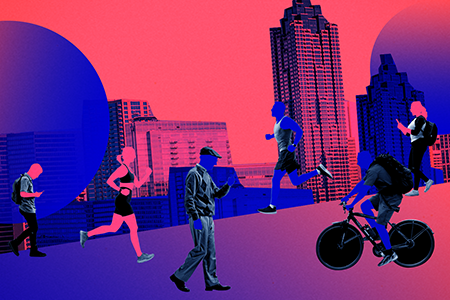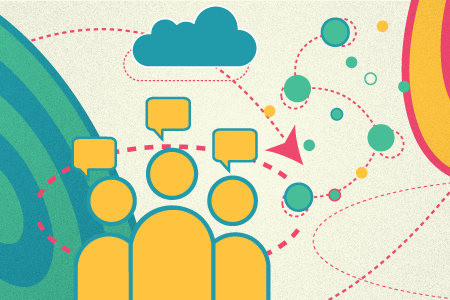
Design Provocations for a Post-COVID World
Designing products and services that people love requires a deep understanding of evolving consumer behaviors. In recent history, we’ve often relied on behavior changes driven by emerging technology as the primary source of innovation opportunities. However, the global COVID-19 pandemic has proven to all of us that it’s not just technology that changes the world. Public health emergencies have the same potential to disrupt long-held social norms, buying behaviors and business models.
Now that the roots of many old routines have been torn out of the ground, behaviors that were once understood as second nature can now be questioned. Do we have to go to universities that require decades of student debt? Do weddings have to always take place in person? Can we have online relationships that are just as meaningful as physical ones?
This type of systemic change is an unfolding process with myriad interdependencies that we cannot pretend to completely understand or control. Some changes may be short-lived. Some may never occur. Even with the uncertainty, it’s our duty as designers to explore what’s likely to change the course of the human experience—and what new opportunities for innovation may arise.
Below are design provocations based on five key consumer behavior changes we’ve been observing and talking about since the crisis began in early 2020.

1. Communities Build Resilience
Better Sanitation, Flexibility and Local Support
People and communities often bounce back from health crises with innovations that multiply the strength of their towns and cities in the long-run. Nineteenth century cholera outbreaks inspired the design of Central Park and other critical sanitation innovations. Moving forward, we anticipate people will continue to seek benefits of cleaner shared spaces, community self-reliance and flexibility of remote collaboration. In the long-run, it will reduce barriers to growth, both economically and socially.
The new community resilience might manifest as a growing customer preference for venues that have implemented health passports/check-in systems or elegantly distanced environments. Neighbors may come together more regularly on managing a community garden, or subscribing to a local farmshare. To supplement lost face-to-face time, school teachers may visit micro groups of students each week in spaces designed for safe in-person learning—creating new education experiences that replace existing models.
Design Provocations:
- If your business had to serve just one city block, how would you adapt? How could you personalize your offering to the precise needs of different neighborhoods? How would you redesign your service to serve only five customers at a time?
- If your business could only operate outdoors, what would it look like? How could you design a no-touch customer experience? How could your business help other businesses adapt to social distancing measures?

2. Mental Well-Being Takes Priority
The Stigma Fades Away
During this pandemic, many have become very attentive not only to their personal hygiene and physical wellness rituals, but also to the condition of their mental health. Looking forward, we anticipate consumers may likely continue to be attracted by products and services that have a positive effect on their mental well-being and feeling of safety.
This de-stigmatization of mental health might result in employers offering weekly sessions with digital therapists as a benefit to attract and retain talent. As a way of tracking and improving one’s well-being, the habit of sharing data about stress levels and mental health indicators could become as comfortable and common as sharing steps and jogging statistics. Larger organizations such as banks could provide mental and social well-being support in order to reduce future risks of financial trouble.
Design Provocations:
- How might your product or service improve mental well-being? How could your business differentiate through mental well-being? What data about your customers could we provide to them that may help improve mental health?
- Who would be a surprising healthcare partner to your business? If you could partner with any healthcare company or business to introduce a new offering to the market that improves well-being, who would it be?

3. Conscious Consumption
Making Money Go Further, Sustainably
The cocktail of economic and emotional shock caused by the global pandemic could very well rattle consumption culture in the years to come. The economic reopening will see a greater number of conscious consumers—ones that are thrifty, resourceful and more disciplined in how they use cash and time. Sharing economy, upcycling and circular economy services may grow, even becoming mainstream status symbols rather than niche economies.
This focus on conscious consumption means customers will make purchases based on their high upcycling potential, or because the brand is aligned with their ethical values or committed to improving social outcomes. As a result, they may prioritize durability and material quality over purchases that offer only short-term benefit, while also opting-in for new reuse and recycle solutions emerging in the market. Through the adoption of new zero-waste platforms, consumers will become more aware of alternative food resources in their surroundings, allowing them to make ethical purchases, while staying within their budget.
Design Provocations
- If you had to reduce your product or service features by 50%, what would it look like? What is the most simple expression of your brand’s value proposition? How would you express your brand’s purpose with a single feature?
- If your product has to be recycled into something else at the end of its lifecycle, what would it be? Alternatively, what materials could you recycle or repurpose to create a new version of your product/service?

4. A Growing Digital Existence
Deeper Connections in the Digital Realm
When physical movement was restricted by lockdown, digital space exploded with activity. The meetings that make the world economy spin moved into laptop screens, an online game transformed into the world’s most intense, psychedelic and crowded concert venue, wedding celebrations were hosted over video calls, people graduated in virtual worlds in Minecraft and a generation of students moved to digital classrooms. Sure there have been some gaffes and awkward moments in the process, but the relative amount of success stories reflects our ability to adopt a new set of digital-social behaviors.
It’s possible one’s inner circle would expand and become more evenly distributed between in person and digital realities. These relationships might become deeper and more meaningful, as they may have the possibility to ‘spend time together’ socializing online in new forms. To bring back the feeling of face-to-face interactions, digital events will become increasingly immersive, including weddings, funerals, concerts and festivals.
Design Provocations
- What would your product/service look like if delivered in virtual reality?If your company never again had a storefront or physical operation center, how might you offer a virtual-only product or service? What would your customer see and experience in virtual reality?
- How could you deconstruct your customer experience into digital and physical components? Which components could take place in a digital environment? Which components would be delivered in-person? What impact would that have for your business and your customers?

5. The Evolving Home
Home, Sweet Office, Classroom, Gym, Etc.
Since the lockdown began, many houses have become multi-purpose spaces with more people than ever working, socializing, learning and exercising from the comfort/discomfort of their own homes. We began to transform layouts, use forgotten spaces and buy new furniture, slowly transforming the contemporary paradigm of the home into something new and functional. Our homes became a powerful weapon in the fight against contagion and isolation, unlocking new layers of its purpose, comfort, safety and usefulness.
Moving forward, we expect to see the home, and in-home behaviours, evolve. We are likely to see a blending of work-time and family time throughout the day, rather than being concentrated in the evenings. The home will need to support more “modes” as people bring the gym, school, and cafe into the home. Common areas may be re-designed in modular formats to enable greater fluidity throughout the day. With more people in the house more often, homeowners may invest more time and money into optimizing home energy usage and air quality.
Design Provocations
- If 9-to-5 is no more, what new product or service opportunities does this create? How would you redesign your business if the 40-hour work week disappeared? What new use cases may emerge from a more distributed work-life integration?
- If you had to design your product or service into the construction of a new home, what would it look like? Where and how would people inside the home use it? What activities and occasions inside the home would your product or service support?

Craig helps firms navigate the crossroads of design and business strategy, focusing on product strategy and business model design. He is particularly interested in combining ethnography with quantitative analysis to map evolving and underserved customer needs.

Zuzana puts users and customers at the center of her methodologies and frameworks to generate a holistic understanding behind solutions, and enable the identification of gaps in end-to-end experiences. She is passionate about in-field-research as a way of creating a deep understanding, in which we can partner with clients to discover and co-create opportunities for innovation. She has expertise in mapping and shaping experiences in finance and healthcare, designing across channels, to ensure consistent and rational solutions—both from the point of view of the user, as well as the client.
We respect your privacy
We use Cookies to improve your experience on our website. They help us to improve site performance, present you relevant advertising and enable you to share content in social media. You may accept all Cookies, or choose to manage them individually. You can change your settings at any time by clicking Cookie Settings available in the footer of every page. For more information related to the Cookies, please visit our Cookie Policy.


